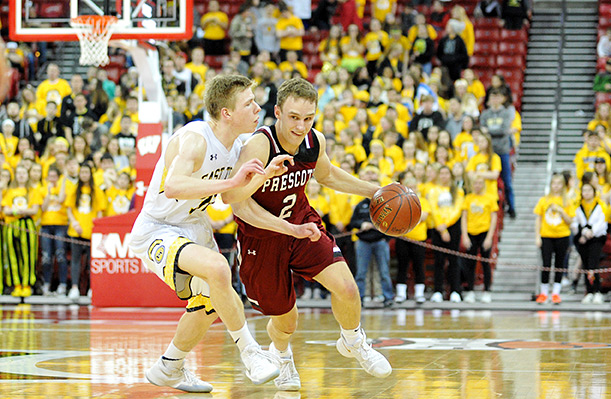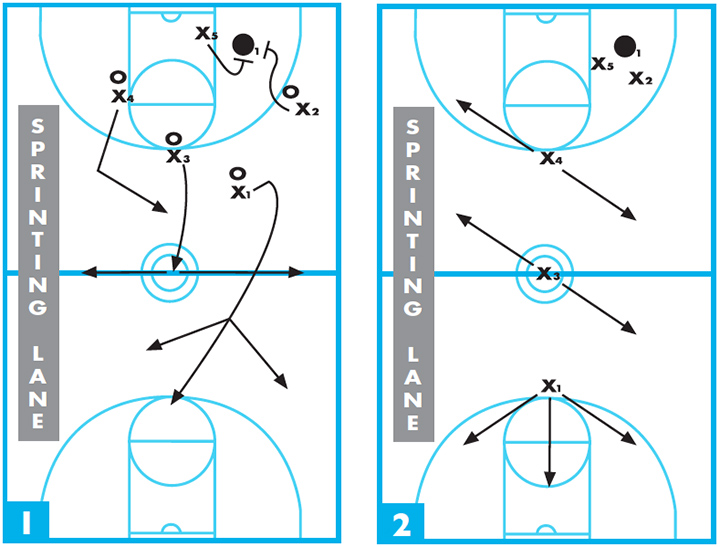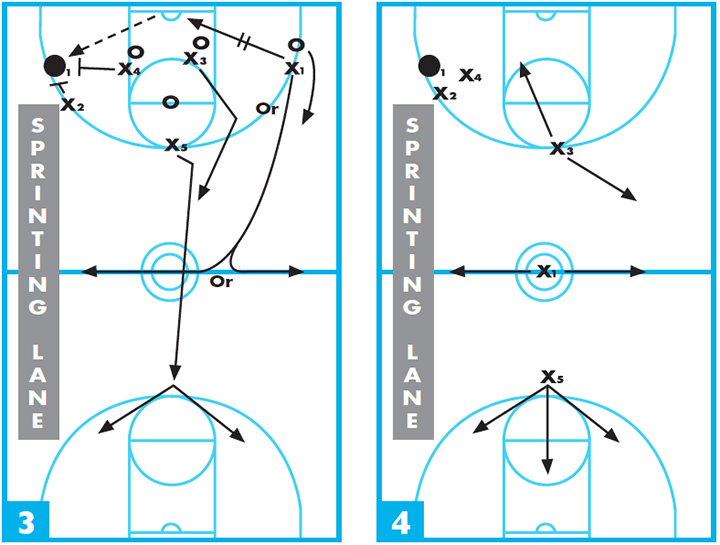‘Thunder & Lightning’ trapping press unleashes relentless pressure
For a full-court press to be successful, you must continuously stress the importance of attitude and communication among players. We developed a full-court trap named “Thunder & Lightning” because thunder represents power, and lightning represents quickness. On every possession, we want our players to hit the opponent with power, quickness and relentless pressure.
 There are four critical ingredients that must be in place to successfully trap full-court, man-to-man.
There are four critical ingredients that must be in place to successfully trap full-court, man-to-man.
1. Pressure.
Based on the location of the offensive rebounder, immediate pressure is applied by the person closest to the ball. The pressure must be smothering to the point that it forces the ball handler to begin their “line of dribble” toward either sideline.2. Assignment.
The assignment of each defender stems from the lead defender’s shoulders. If the second-line help is to the left of the lead defender, this person has left-wing responsibility. The same rules apply for the right side. The supporting defenders located near or close to the middle of the paint must drop and sprint to take on midcourt responsibility. Lastly, the defender nearest to the top of the key must drop and sprint to defend the basket.
» ALSO SEE: The 18 characteristics of a good defensive team
DIAGRAM 1: Immediate trap (off short rebound). In this example, the rebounder was defended by X5 and X2, while X4 becomes “wing support.” X3 drops and sprints to midcourt for outlet support, and X1 sprints downcourt to defend our basket.

X5 immediately forces the ball toward the right sideline once the rebound comes off of the rim. X2, on the right wing, brings a high-pressure trap to the ball with hands up high. With both defenders’ hands up, it forces the ball handler to either reverse the ball or throw a cross-court lob pass.
DIAGRAM 2: Steals off passes out of traps. X4 shadows the middle for reverses or short passes to the area. X3 covers any long lob passes, while X1 defends the basket and looks to pick off any long “bomb” or “baseball” passes. He or she must always be prepared take a charge on layups if the offense gets downcourt quickly.
3. Movement.
Practice habits are critical to getting players used to the types of movements used in this press. This defense fails if players aren’t sprinting to get in position to apply pressure on the ball and set up steals from cross-court lobs. When this is lacking, your opponent breaks the press and scores easily and often. Practice top-of-the-key to top-of-the-key sprinting drills.
4. Close-outs.

Each defender must take a close out “line of attack” toward the ball, which prevents the offensive player from splitting defenders. Proper close-outs also allow the defense to keep high pressure on the ball, while stopping quick-scoring opportunities.
DIAGRAM 3: Immediate traps (off long rebounds). When 3-point shooters miss shots, the rebound trajectory is long. In this example, X2 defends the rebounder, while X4 traps immediately from the baseline. X5 sprints downcourt to defend the basket, while X3 covers the opposite wing for support and looks for a steal on any ball reversals or short passes across the middle. X1 shadows midcourt players, looking to pick off cross-court lobs.
DIAGRAM 4: Steals off passes out of traps. As X2 and X4 trap the ball, X3, X1 and X5 look to pick off any passes out of the trap. X5 stays back, defends any incoming layups, takes charges, or forces the ball handler to pull up, allowing time for all teammates to get back on defense.









